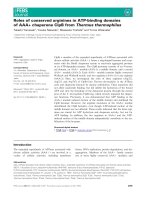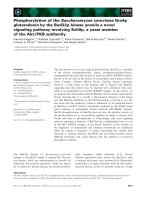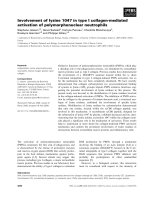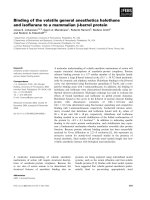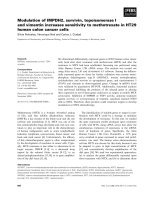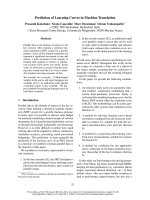Báo cáo khoa học: "Relationship of cognitive function in patients with schizophrenia in remission to disability: a cross-sectional study in an Indian sample" pps
Bạn đang xem bản rút gọn của tài liệu. Xem và tải ngay bản đầy đủ của tài liệu tại đây (269.7 KB, 8 trang )
BioMed Central
Page 1 of 8
(page number not for citation purposes)
Annals of General Psychiatry
Open Access
Primary research
Relationship of cognitive function in patients with schizophrenia in
remission to disability: a cross-sectional study in an Indian sample
Rajeev Krishnadas*
1
, Brian P Moore
1
, Ajita Nayak
2
and Ramesh R Patel
3
Address:
1
Tranwell Unit, Queen Elizabeth Hospital, Gateshead, Tyne and Wear, UK,
2
BYL Nair Hospital, AL Nair Road, Mumbai, India and
3
Bhatia
Hospital, Tardeo, Mumbai, India
Email: Rajeev Krishnadas* - ; Brian P Moore - ; Ajita Nayak - ;
Ramesh R Patel -
* Corresponding author
Abstract
Background: Cognitive deficits in various domains have been consistently replicated in patients
with schizophrenia. Most studies looking at the relationship between cognitive dysfunction and
functional disability are from developed countries. Studies from developing countries are few. The
purpose of the present study was to compare the neurocognitive function in patients with
schizophrenia who were in remission with that of normal controls and to determine if there is a
relationship between measures of cognition and functional disability.
Methods: This study was conducted in the Psychiatric Unit of a General Hospital in Mumbai, India.
Cognitive function in 25 patients with schizophrenia in remission was compared to 25 normal
controls. Remission was confirmed using the brief psychiatric rating scale (BPRS) and scale for the
assessment of negative symptoms (SANS). Subjects were administered a battery of cognitive tests
covering aspects of memory, executive function and attention. The results obtained were
compared between the groups. Correlation analysis was used to look for relationship between
illness factors, cognitive function and disability measured using the Indian disability evaluation and
assessment scale.
Results: Patients with schizophrenia showed significant deficits on tests of attention,
concentration, verbal and visual memory and tests of frontal lobe/executive function. They fared
worse on almost all the tests administered compared to normal controls. No relationship was
found between age, duration of illness, number of years of education and cognitive function. In
addition, we did not find a statistically significant relationship between cognitive function and scores
on the disability scale.
Conclusion: The data suggests that persistent cognitive deficits are seen in patients with
schizophrenia under remission. The cognitive deficits were not associated with symptomatology
and functional disability. It is possible that various factors such as employment and family support
reduce disability due to schizophrenia in developing countries like India. Further studies from
developing countries are required to explore the relationship between cognitive deficits, functional
outcome and the role of socio-cultural variables as protective factors.
Published: 30 July 2007
Annals of General Psychiatry 2007, 6:19 doi:10.1186/1744-859X-6-19
Received: 15 February 2007
Accepted: 30 July 2007
This article is available from: />© 2007 Krishnadas et al; licensee BioMed Central Ltd.
This is an Open Access article distributed under the terms of the Creative Commons Attribution License ( />),
which permits unrestricted use, distribution, and reproduction in any medium, provided the original work is properly cited.
Annals of General Psychiatry 2007, 6:19 />Page 2 of 8
(page number not for citation purposes)
Background
Neurocognitive dysfunction has been postulated as a core
deficit in many major mental illnesses [1-3]. Rather than
a gene that is linked to a specific illness, it is proposed that
deficits in information processing could be endopheno-
types that are inherited [4]. A constellation of these core
cognitive deficits (endophenotypes) in various combina-
tions and severity have a role in the emergence of well
established psychopathology of the disease. It has been
suggested that people with a lower cognitive reserve tend
to have psychosis-like experiences more readily compared
to those with a greater cognitive reserve [5].
Cognitive deficits in various domains have been consist-
ently replicated in patients with schizophrenia [1]. Longi-
tudinal studies have confirmed that most deficits are trait
abnormalities, persistent and stable over time [6]. In
patients with schizophrenia, delusions and hallucinations
could arise as a result of deficits in cognitive functions
involving perceptual and attributional biases [7,8].
People with schizophrenia are known to have problems
with initiation and maintenance of social activity. Access
to public funds early in the illness and dependence on
them is an indicator of the severity of functional deterio-
ration. This deterioration takes place early in the illness
process [9]. Data from industrialized nations show that
only around 10% of patients diagnosed with schizophre-
nia are working in full-time employment.
Most studies that link cognitive deficits to functional out-
come in schizophrenia support the notion that neurocog-
nitive function predicts social and occupational function.
Measures of immediate memory, delayed memory, and
executive function have been found to predict functional
outcome with small to medium effect size [10]. Moreover,
cognitive function has been found to be a better predictor
of functional outcome than symptom levels [11].
Cross-cultural studies have found that outcome of schizo-
phrenia is better in developing countries [12,13]. The
most recent data from the Madras longitudinal study,
which followed up patients with first episode schizophre-
nia for 20 years, found that more than 75% of patients
remained employed at the end of 20 years. The reasons
postulated for this difference in outcome being the possi-
bility of a biological difference, or the presence of socio-
cultural factors that protect from functional deterioration
[14].
Although cognitive deficits in patients with schizophrenia
have been shown in the Indian population [15-17], very
few have looked at the relationship between cognitive
dysfunction and functional disability. The present report
documents a cross-sectional study that aimed to compare
the cognitive function in people suffering from schizo-
phrenia, but were in remission, with that of normal sub-
jects. We explored a relationship between the
demographic and illness variables, cognitive function and
functional outcome as measured by the Indian disability
evaluation and assessment scale (IDEAS) [18].
Methods
The study took place in the Department of Psychiatry, BYL
Nair Hospital, a municipal general hospital in Mumbai,
India. It received ethical approval from the institutional
review board at Nair Hospital. Written informed consent
was obtained from all subjects to participate in the study,
and they were free to withdraw at any time.
Subjects
A total of 25 subjects were recruited into the study from
the outpatient clinics of BYL Nair hospital, Mumbai. We
included patients aged 18–60 years old, with a diagnosis
of schizophrenia according to DSM IV [19] criteria, made
by an investigator (RK) and confirmed by senior psychia-
trists (AN and RRP). The diagnosis of schizophrenia was
made at clinical interview and augmented by discussion
with relatives and a review of clinical notes. Similarly, co-
morbid Axis I and II diagnoses were excluded. This was
confirmed from the case notes and history from the rela-
tives. Remission was ascertained clinically using a cut off
total score of 8 with a score of 2 or less on individual items
on the brief psychiatric rating scale (BPRS) [20] and scale
for the assessment of negative symptoms (SANS) [21].
Subjects with significant physical and neurological illness;
a history of stroke or head trauma in the past; a history of
alcohol or drug misuse; a mini mental state examination
(MMSE) score of less than 28; a history of receiving elec-
tro-convulsive therapy (ECT) in the past six months; evi-
dence of co-morbid Axis I or II psychiatric disorder; and a
childhood history suggestive of mental retardation (DSM
IV) [19] were excluded from the study. Demographic
details, illness variables and treatments were recorded
using a semi-structured proforma. Controls were healthy
subjects who had no family history of major psychiatric
illness in a first-degree relative. They conformed to the
same exclusion criteria as the participants with schizo-
phrenia.
Procedure
All subjects who were included in the study were assessed
once using a battery of tests for cognition that lasted from
1 h 15 min to 2 h. Assessments were performed in a fixed
order in a quiet room by RK. At the subject's request, a
short break was permitted halfway through the assess-
ment. Patients were not allowed to smoke or consume
stimulant drinks during the assessment. The last dose of
medication was taken at least 6 h before the testing.
Annals of General Psychiatry 2007, 6:19 />Page 3 of 8
(page number not for citation purposes)
Cognitive function
The PGI memory scale
The PGI memory scale [22] is part of the PGI battery of
brain dysfunction, developed at PGIMER, Chandigarh,
India. The battery is administered in Hindi, the first lan-
guage of most subjects, and has been developed and vali-
dated for use in the Hindi-speaking population. It
includes 10 subtests, of which we used the 7 that meas-
ured various aspects of verbal and visual memory. These
included forward and backward digit spans, 1 min
delayed recall of a word list, immediate recall of sen-
tences, retention of similar word pairs, retention of dis-
similar pairs, and visual retention and visual recognition.
We excluded three tests from the analysis (recent memory,
remote memory and mental balance test) because they
demonstrated a ceiling effect.
Trail making tests A and B
Trail making tests A and B have been commonly used and
validated in the Indian population [23]. Trail shift scores
were calculated by subtracting the time taken on Trail
making A from the time taken on Trail making B test.
Rey-Osterrieth complex figure test
The Rey-Osterrieth complex figure test [24] is used to eval-
uate both visuo-constructional ability and visual memory.
The accuracy of the immediate and the 30 min recall ver-
sions were assessed using the standardized scoring system.
Frontal Assessment Battery (FAB)
The frontal assessment battery (FAB) [25] is a short cogni-
tive and behavioral battery that assesses frontal lobe func-
tion. It has six subtests, each of which has been shown to
correlate with frontal lobe metabolic activity measured by
18 flurodeoxyglucose on a PET scan [26]. The subtests are
similarities (tests conceptualization and abstract reason-
ing), verbal fluency (tests word generation), Luria's motor
series test (tests motor series programming requiring tem-
poral organization, maintenance and execution of succes-
sive action), conflicting instructions (tests sensitivity to
interference, where verbal commands conflict with visual
sensory information), go/no go (tests the ability to inhibit
an inappropriate response to tasks anticipated to elicit a
false alarm motor response), and prehension behavior
(checks the environmental autonomy).
Disability assessment
The Indian Disability Evaluation Assessment Scale
(IDEAS) was developed by the rehabilitation committee
of the Indian Psychiatric society [18]. It assesses the indi-
vidual under four domains: self care, interpersonal activi-
ties (social relationships), communication and
understanding, and occupation, including performance at
employment/housework/education. Each item is scored
between 0–4, i.e., from no to profound disability. Adding
the scores on the four items gives the 'total disability
score'. IDEAS has been field tested in nine centers all over
India. Internal consistency between items was good, with
a Cronbach's alpha value of 0.87. It has good face and cri-
terion validity, established by comparing IDEAS with the
Schedule for the Assessment of Psychiatric Disability
(SAPD), which has been standardized in the Indian pop-
ulation.
Statistical analysis
Data was analyzed using SPSS v 12 [27]. Data were
checked for normality using the Kolmogorov-Smirnov
test. When it was found to be non-normal, data was ana-
lyzed using non-parametric methods. Difference between
groups was tested using unpaired t tests or the Mann-
Whitney U test where appropriate. Categorical data was
compared using Chi-square tests, and where the expected
value was less than 5 in a cell, an exact test on unordered
contingency tables was used [28]. Associations between
socio-demographic data, illness variables, disability score
and neurocognitive performance were explored using the
Spearman's correlation, as most data on cognitive tests
did not assume normality. To reduce the risks of type 1
error from repeated hypothesis testing, a significance level
of p ≤ 0.01 was adopted on all tests.
Results
Subject characteristics
There were a greater proportion of females in the schizo-
phrenia group compared to the control group, but the dif-
ference was not statistically significant. The mean age of
the patient group was higher than the controls but the
number of years of education was slightly higher in the
control group. The mean duration of illness was 11.3 ± 5.8
years, ranging from 2 to 20 years. A total of 24% of the
patients were unemployed, whereas there were no unem-
ployed subjects in the control group, a difference that was
statistically significant (Chi-square = 3.6E-07, p < 0.001).
Mean BPRS, Hamilton rating scale for depression (HRSD)
and the SANS scores are shown in Table 1. Although the
mean scores were clinically low, they were found to be sta-
tistically higher than the control population. Mean score
on total IDEAS was 2.16 (SD ± 2.267).
Details of medication are shown in Table 1. A total of 96%
of the patient group was on a typical antipsychotic, and an
equal number were on an anticholinergic medication.
32% of the patients took a benzodiazepine.
Neurocognitive function
Results are reported according to the domains of cogni-
tion tested (Table 2). Patients with schizophrenia scored
less well than controls on all tests of cognition, except vis-
ual recognition.
Annals of General Psychiatry 2007, 6:19 />Page 4 of 8
(page number not for citation purposes)
Attention and vigilance
Trail making test A has been found to be a good measure
of attention and vigilance (sustained attention). People
with schizophrenia took significantly longer time than
controls to complete the task.
Immediate and working memory
Patients with schizophrenia scored significantly lower on
immediate sentence recall and digit span tests. Perform-
ance on similar and dissimilar pair retention was worse in
the patient group. Patients fared worse on the visual reten-
tion subtest of the Postgraduate Institute memory scale
Table 2: Comparison of cognitive tests between the two groups
CONTROLS SCHIZOPHRENIA
TESTS Mean (SD) Mean (SD) Z (U)* p
Digit forward 5.92 (0.28) 3.52 (0.65) -6.442 (2.000) <0.001
Digit backward 4.36 (0.49) 2.32 (0.69) -6.129 (8.000) <0.001
Immediate recall 11.88 (0.44) 3.84 (0.99) -6.431 (0.000) <0.001
Delayed recall 9.92 (0.28) 6.52 (1.94) -6.262 (8.000) <0.001
Verbal retention: similar pairs 5.00 (0.00) 3.44 (0.77) -5.981 (37.500) <0.001
Verbal retention: dissimilar pairs 14.84 (0.37) 5.96 (1.31) -6.334 (0.000) <0.001
Visual retention 12.88 (0.33) 6.24 (2.18) -6.353 (0.000) <0.001
Visual recognition 9.96 (0.20) 9.68 (0.48) -2.551 (225.00) 0.011
Trail making A 39.80 (3.00) 77.24 (18.87) -5.973 (6.000) <0.001
Trail making B 79.72 (7.71) 150.76 (17.32) -6.074 (0.000) <0.001
Trail shift 39.92 (6.33) 73.52 (27.43) -4.980 (56.000) <0.001
Total FAB 9.60 (1.35) 18.00 (0.00) -6.507 (0.000) <0.001
ROCFT 1 35.36 (0.81) 31.64 (1.32) -6.121 (2.500) <0.001
ROCFT 2 27.72 (1.57) 14.36 (2.51) -6.085 (0.000) <0.001
*Mann-Whitney U test. Mean (SD) reported for ease of interpretation of data. All tests considered significant if p < 0.01.
Table 1: Demographic and illness characteristics of groups
GROUP
Schizophrenia Control p
Gender:
Female, n (%) 9 (36) 7 (28) 0.368 0.544
Male, n (%) 16 (64) 18 (72)
Age, years: mean (sd) 40.16 (8.153) 35.48 (5.49) t = 2.380 0.021
Years in education 9.08(1.470) 9.92 (1.038) t = -2.335 0.024
Duration of illness, mean (SD) 11.32(5.8) -
Employment:
Unemployed 6 0 3.6E-07* <0.001
Self employed 6 0
Govt/private salaried 6 22
Home maker 7 3
BPRS, mean (SD) 3.68 (1.249) 0 t = 14.732 <0.001
HRSD, mean (SD) 1.36 (.952) 0 t = 7.141 <0.001
MMSE, mean (SD) 29.80 (.408) 29.92 (.277) t = -1.216 0.230
SANS, mean (SD) 2.68 (.690) 0 t = 19.4 <0.001
IDEAS, mean (SD) 2.16 (2.267) -
Medication:
Typical antipsychotics 22(88) -
Atypical antipsychotics, n (%) 1 (4) -
Combination of antipsychotics 2 (8) -
Benzodiazepine, n (%) 8 (32) -
Anticholinergics, n (%) 24 (96) -
Antidepressant, n (%) 3 (12) -
*Exact test on unordered contingency tables.
Annals of General Psychiatry 2007, 6:19 />Page 5 of 8
(page number not for citation purposes)
(PGIMS) and the Rey-Osterrieth complex figure test
(ROCFT) immediate visual recall.
Delayed memory
Delayed recall assesses verbal episodic memory. Patients
with schizophrenia recalled significantly less number of
words compared to normal controls. Visual episodic
memory on ROCFT recall at 30 min was worse in patients
with schizophrenia, compared to controls. There was no
difference in scores of visual recognition test between the
patients and controls.
Executive funtion
Patients with schizophrenia fared worse than controls on
the frontal assessment battery. The only test in the FAB, on
which the two groups scored similarly, was the environ-
mental autonomy subtest. Reverse digit span and Trail
making B test also tests the executive function, i.e. the
ability to manipulate data 'online'. On Trail shift, the dif-
ference between the performance on Trail A and B (Trail
B-A), was significantly worse in patients with schizophre-
nia. These findings suggest a frontal executive dysfunc-
tion. Correlation of demographic details, illness variables
and disability with cognitive function.
To compensate for multiple testing, we considered an
association to be significant only if the correlation coeffi-
cient was significant at p ≤ 0.01. No significant association
was found between age, duration of illness, number of
years in education and scores on the neurocognitive tests
(Table 3). There was no significant meaningful correlation
between the scores on the tests and the scores on SANS,
BPRS and HRSD. There was also no significant correlation
between negative and positive symptoms score and score
on IDEAS. Although there was no significant relationship
between scores on the cognitive tests and scores on
IDEAS, the negative correlation between the scores on
backward digit span and immediate recall and the score
on IDEAS showed a trend towards significance at p =
0.017 and 0.014 respectively.
Discussion
Cognitive dysfunction
Our study replicates the findings of numerous studies that
demonstrated the presence of neurocognitive deficits in
patients with schizophrenia on most domains tested,
including attention, vigilance, immediate memory, work-
ing memory, delayed memory and executive function [1].
A recent study from India compared the cognitive func-
tioning of 100 symptomatic subjects with chronic schizo-
phrenia to equal number of normal controls. It found that
people with schizophrenia performed worse on all cogni-
tive tests involving memory, attention and executive func-
tion [15]. The findings of the present study show that
cognitive deficits are persistent even during periods of
remission, suggesting the 'trait' nature of the deficits. The
similarity of cognitive deficits across cultures also indi-
cates that the deficits could constitute 'traits' of the illness.
Memory deficits in Schizophrenia
Poor performance by the patients on digit span and
immediate recall of sentences suggests a deficit in working
memory model as proposed by Baddeley [29]. Semanti-
cally paired items on a word list did not improve perform-
ance on immediate recall. This is in keeping with earlier
findings, which suggested that phonological similarity is
more important than semantic similarity in short-term
memory. In contrast, long-term memory depends more
strongly on meaning and phonological similarity is less
important. Deficits on immediate visual recall of the
ROCFT and visual retention suggest a deficit in the 'visu-
ospatial sketchpad' on Baddeley's model. A deficit in the
'central executive' is suggested by the poor performance of
the patients on the Trail making B test. Patients performed
less well on Trail making A test, which could indicate that
Table 3: Correlation (Spearmans) among variables
Age No. of years in education Duration of illness in years Total IDEAS HRSD BPRS SANS
Digit forward 0.242 0.011 0.119 -0.396* 0.298 -0.131 0.075
Digit backward 0.321 0.109 0.337 -0.474* 0.043 0.065 0.102
Immediate recall 0.035 -0.086 -0.132 -0.483* 0.395 -0.127 0.226
Delayed recall 0.350 -0.063 0.307 -0.403 0.149 -0.065 -0.175
Verbal retention: similar pairs 0.259 -0.002 0.078 -0.385 0.399* -0.286 0.145
Verbal retention: dissimilar pairs 0.548** -0.136 0.317 -0.274 0.306 -0.139 0.209
Visual retention 0.139 0.326 0.089 -0.291 0.081 0.042 -0.284
Recognition -0.197 -0.045 -0.137 -0.301 0.243 0.012 -0.078
Trailmaking A -0.392 -0.003 -0.280 -0.027 0.316 -0.092 0.206
Trailmaking B -0.141 0.054 -0.158 -0.077 -0.073 0.091 -0.585**
ROCFT 1 -136 0.040 -0.244 0.198 0.085 0.240 0.082
ROCFT 2 -0.140 0.087 -0.167 0.160 0.053 -0.116 0.291
Total FAB -0.106 0.027 -0.178 -0.136 0.193 -0.260 0.096
*p < 0.05; **p < 0.01. Correlations considered significant if p < 0.01.
Annals of General Psychiatry 2007, 6:19 />Page 6 of 8
(page number not for citation purposes)
they had attention deficits. Although reduced attention
could explain many cognitive deficits in the patient
groups, their poorer performance on 'trail shift' indicates
that their executive deficits might be partially independ-
ent of the attention deficits. Poor performance on 1 min
verbal delayed recall and 30 min recall on the visual
ROCFT suggests a deficit in circuits involving delayed
memory.
Demographic factors, Illness variables and cognition
The present study found no relationship between age,
duration of illness, psychopathology and cognitive func-
tion, suggesting that the deficits are trait deficits and are
stable over the course of the illness. Previous longitudinal
studies have confirmed the stable nature of cognitive def-
icits in patients with schizophrenia [6]. Srinivasan et al.
reported a relationship between age, duration of illness,
duration in formal education and neurocognitive func-
tion in a sample of Indian patients [15]. There is some evi-
dence to suggest that older patients with schizophrenia
(>65) show a progressive decline in cognitive functioning
compared to younger patients [30].
Symptomatology and functional outcome
Previous studies performed in the Western population
have found an association between negative symptoms
and a poor functional outcome. Brier et al. found that neg-
ative symptoms measured using SANS correlated to poor
functional outcome measured using the Global assess-
ment scale [31]. Johnstone et al. found that social with-
drawal predicted functional outcome [32]. One small
study, which included 19 patients with schizophrenia,
found that symptoms measured using BPRS and SANS did
not predict outcome [33].
A recent study that measured psychopathology using the
Positive and Negative Syndrome Scale (PANSS) and disa-
bility using IDEAS in an Indian population showed a pos-
itive correlation between scores on all three PANSS
subscales and scores on IDEAS, suggesting a relationship
between levels of symptomatology and disability. The
study did not measure cognitive functioning of the
patients. [34]. Our study did not show a relationship
between symptomatology and functional outcome. This
could be explained by the low level of symptoms in the
study population, because we recruited only patients who
fulfilled the criteria for remission.
Cognitive function and disability
The present study did not find a strong association
between cognitive function and disability. Although this
is in contrast to most previous studies, a few studies have
shown similar results. Johnstone et al. in a study of 137
first episode patients found that neurocognitive function
measured using the Peabody picture vocabulary test and
digit symbol substitution test did not correlate with occu-
pational functioning [32]. Addington et al. found no asso-
ciation between cognitive measures and social
functioning in 30 patients with schizophrenia [35]. The
reason for these differences is unclear.
Our measured correlates in many cases were high, often
up to 0.45, which would explain 20% of the total sample
variance. However, we corrected for multiple compari-
sons to decrease the chance of false positive. But in doing
so, discounted correlates with p value lying between 0.05
and 0.01. Hence, few correlates were regarded as signifi-
cant.
These findings could also be attributed to 75% of the sam-
ple that remained employed in spite of the significant cog-
nitive deficits. Similar employment rates have been
shown in previous studies from India [14]. The findings in
the present study emphasize the importance of protective
factors that could play a role in the functional outcome of
patients in spite of cognitive deficits. Although there is no
strong evidence, socio-cultural factors have been impli-
cated as a reason for better prognosis in developing coun-
tries. Families in India, play a major role in patient
management. They take up the responsibility for the
patient's compliance with medication and support them
in times of crisis and need, functions, which in the West
are carried out by assertive outreach teams, crisis teams
and community mental health teams, and are believed to
improve outcome [36]. Further, the absence of access to
social security and public funds in the form of disability
allowance might have contributed to the pressure to earn
for a living and hence the high employment rate. Employ-
ment might offer the patient a form of practical social and
functional rehabilitation. The possibility of finding a job
in the unorganized sector as street vendors and manual
labourers make it easy for people to earn a living and
remain functional from an employment point of view
[36]. All the patients who participated in our study were
living with their families and had good support. Further
studies are required to confirm the hypothesis of socio-
cultural factors impacting on the outcome of schizophre-
nia [37].
The study has a number of limitations. First of all, the
small sample size might have led to a type 2 error. We did
not test the premorbid intelligence (and hence the cogni-
tive reserve) of the patients, although any history sugges-
tive of a developmental delay was excluded from the
participants. All patients in our study were on medica-
tions, including typical antipsychotics, anticholinergics
and benzodiazepines, known to cause cognitive deficits.
Although previous studies on first episode drug naïve
patients have confirmed that the deficits are independent
of medication, the possibility of the medications worsen-
Annals of General Psychiatry 2007, 6:19 />Page 7 of 8
(page number not for citation purposes)
ing the cognitive functioning cannot be ruled out [38].
Recent consensus suggests a time criterion of 6 months in
defining remission [39]. The present study did not con-
firm remission prospectively. The investigator who
administered the test was not blind to the diagnosis, and
this might have lead to unintentional observer bias. It is
not known how generalisable the data is to community,
where symptoms might not be as controlled as in the pop-
ulation tested.
Conclusion
Persistent cognitive deficits are seen in patients with schiz-
ophrenia under remission when compared to normal
controls. The cognitive deficits are not associated with
symptomatology and disability. It is possible that various
factors such as employment and family support reduce
disability due to schizophrenia in developing countries
like India. These factors either compensate for the deficits
or act as natural social and functional remediation. Fur-
ther longitudinal studies from developing countries are
required to explore the relationship between cognitive
deficits, functional outcome and the role of socio-cultural
variables as protective factors.
Competing interests
The author(s) declare that they have no competing inter-
ests.
Authors' contributions
RK was involved in the conceptualization of the study, lit-
erature review, recruiting patients, data collection, statisti-
cal analysis and interpretation of results. PBM was
involved in review of the manuscript including extensive
revision of interpretation and discussion of the results. AN
and RRP reviewed the methodology, contributed to
recruiting patients, confirming the diagnosis and interpre-
tation of results.
References
1. Sharma T, Antonova L: Cognitive function in schizophrenia Def-
icits, functional consequences, and future treatment. Psychi-
atr Clin N Am 2003, 26:25-40.
2. Robinson LJ, Ferrier IN: Evolution of cognitive impairment in
bipolar disorder: a systematic review of cross-sectional evi-
dence. Bipolar Disord 2006, 8:103-116.
3. Nielen MMA, Den Boer JA: Neuropsychological performance of
OCD patients before and after treatment with fluoxetine:
evidence for persistent cognitive deficits. Psychol Med 2003,
33:917-925.
4. Braff DL, Freedman R: Endophenotypes in studies of the genet-
ics of schizophrenia. Neuropsychopharmacology: The Fifth Generation
of Progress 2002:703-716 [ />716.pdf]. Philadelphia: Lippincott, Williams & Wilkins
5. Krabbendam L, Myin-Germeys I, Hanssen M, van Os J: Familial cov-
ariation of the subclinical psychosis phenotype and verbal flu-
ency in the general population. Schizophr Res 2005, 74:37-41.
6. Heaton RK, Gladsjo JA, Palmer BW, Kuck J, Marcotte TD, Jeste DV:
Stability and course of neuropsychological deficits in schizo-
phrenia. Arch Gen Psychiatry 2001, 58:24-32.
7. Garety PA, Freeman D: Cognitive approaches to delusions: A
critical review of theories and evidence. Br J Clin Psychol 1999,
38:113-154.
8. Baker CA, Morrison AP: Cognitive processes in auditory hallu-
cinations. Attribution biases and meta-cognition. Psychol Med
1998, 28:1199-1208.
9. Lehman AF, Goldberg R, Dixon LB, McNary S, Postrado L, Hackman
A, McDonnell K: Improving employment outcomes for per-
sons with severe mental illnesses. Arch Gen Psychiatry 2002,
59:165-72.
10. Green MG, Kern RS, Braff DL, Mintz JM: Neurocognitive deficits
and functional outcome in schizophrenia: are we measuring
the 'right stuff'? Schizophrenia Bull 2000, 26(1119-136 [http://schiz
ophreniabulletin.oxfordjournals.org/cgi/content/abstract/26/1/119].
11. Evans JD, Bond GR, Meyer PS, Kim HW, Lysaker PH, Gibson PJ, Tunis
S: Cognitive and clinical predictors of success in vocational
rehabilitation in schizophrenia. Schizophr Res 2004, 70:331-342.
12. Sartorius N, Jablensky A, Korten A, Ernberg G, Anker M, Cooper JE,
Day R: Early manifestations and first-contact incidence of
schizophrenia in different cultures. Psychol Med 1986,
16:909-928.
13. World Health Organization: Schizophrenia: An International Follow-up
Study New York: Wiley; 1979.
14. Thara R: Twenty-year course of schizophrenia: the Madras
longitudinal study. Can J Psychiatry 2004, 49:564-569 [http://
ww1.cpa-apc.org:8080/Publications/Archives/CJP/2004/august/
thara.asp].
15. Srinivasan L, Thara R, Tirupati SN: Cognitive dysfunction and
associated factors in patients with chronic schizophrenia.
Indian J Psychiatry 2005, 47:139-143.
16. Ananthanarayanan CV, Janakiramaiah N, Gangadhar BN: Visual
information processing deficits in clinically remitted outpa-
tient schizophrenics. Indian J Psychiatry 1993, 35:27-30.
17. John PJ, Khanna S, Mukundan CR: Relationship between psycho-
pathological dimensions and performance on frontal lobe
tests in schizophrenia. Indian J Psychol Med 2001, 24:19-26.
18. Indian Psychiatric Society: IDEAS (Indian Disability Evaluation and Assess-
ment Scale) – A Scale for Measuring and Quantifying Disability in Mental
Disorders Chennai: Indian Psychiatric Society; 2002.
19. American Psychiatric Association: Diagnostic and Statistical Manual of
Mental Disorders, (DSM – IV) 4th edition. Washington DC: American
Psychiatric Association; 1994.
20. Overall JE, Gorham DR: The Brief Psychiatric Rating Scale
(BPRS): a comprehensive review. J Operat Psychiatry 1991,
148:472.
21. Andreasen NC: The scale for the assessment of negative
symptoms (SANS): conceptual and theoretical foundations.
Br J Psychiatry 1989, 7(Suppl):49-58.
22. Pershad D, Verma SK: Handbook of PGI Battery of Brain Dysfunction
(PGI-BBD) Agra: National Psychological Corporation; 1990.
23. Mukundan CR: NIMHANS neuropsychological battery: test
descriptions, instructions, clinical data and interpretation. In
Proceedings of the National Workshop in Clinical Neuropsychology: 24–29
October NIMHANS, Bangalore, India Bangalore: NIMHANS Publica-
tions; 1996.
24. Hodges JR: Cognitive Assessment for Clinicians Oxford: Oxford Univer-
sity Press; 1994.
25. Dubois M, Slachevsky A, Litvan I, Pillon B: The FAB: A frontal
assessment battery at bedside. Neurology 2000, 55:1621-1626.
26. Sarazin M, Pillon B, Giannakopoulos P, Rancurel G, Samson Y, Dubois
B: Clinicometabolic dissociation of cognitive functions and
social behavior in frontal lobe lesions. Neurology 1998,
51:142-148.
27. SPSS Inc: SPSS for Windows. Rel 12.0 Chicago: SPSS Inc; 2003.
28. Mehta CR, Patel NR: A network algorithm for performing
Fisher's exact test in rxc contingency tables. J Am Stat Ass 1983,
78:427-434.
29. Baddeley A: Working memory: looking back and looking for-
ward. Nat Rev Neurosci 2003, 4:829-839.
30. McBride T, Moberg PJ, Mahr R, Arnold SE, Gur RE: Neuropsycho-
logical functioning in elderly patients with schizophrenia and
Alzheimer's disease. Schizophrenia Res 2002, 55:217-227.
31. Breier A, Schreiber JL, Dyer J, Pickar D: National Institutes of
Mental Health longitudinal study of chronic schizophrenia:
prognosis and predictors of outcome. Arch Gen Psychiatry 1991,
48:239-246.
32. Johnstone EC, Macmillan JF, Frith CD, Benn DK, Crow TJ: Further
investigation of the predictors of outcome following first
schizophrenic episodes. Br J Psychiatry 1990, 157:182-189.
Publish with BioMed Central and every
scientist can read your work free of charge
"BioMed Central will be the most significant development for
disseminating the results of biomedical researc h in our lifetime."
Sir Paul Nurse, Cancer Research UK
Your research papers will be:
available free of charge to the entire biomedical community
peer reviewed and published immediately upon acceptance
cited in PubMed and archived on PubMed Central
yours — you keep the copyright
Submit your manuscript here:
/>BioMedcentral
Annals of General Psychiatry 2007, 6:19 />Page 8 of 8
(page number not for citation purposes)
33. Goldman RS, Axelrod BN, Tandon R, Ribeiro SC, Craig K, Berent S:
Neuropsychological prediction of treatment efficacy and
one-year outcome in schizophrenia. Psychopathol 1993, 26(3-
4):122-126.
34. Chaudhury PK, Deka K, Chetia D: Disability associated with
mental disorders. Indian J Psychiatry 2006, 48:95-101
[http:www.indianjpsychiatry.org/
article.asp?issn=0015545;year=2006;vol
ume=48;issue=2;spage=95;epage=101;aulast=Chaudhury].
35. Addington J, McCleary L, Munroe-Blum H: Relationship between
cognitive and social dysfunction in schizophrenia. Schizophre-
nia Res 1998, 34:59-66.
36. Thara R, Eaton WW: Ten year outcome of schizophrenia: the
Madras longitudinal study. Aust NZ J Psychiatry 1996, 30:516-522.
37. Patel V, Cohen A, Thara R, Gureje O: Is the outcome of schizo-
phrenia really better in developing countries? Rev Bras Psiquiatr
2006, 28:149-52.
38. Saykin AJ, Shtasel DL, Gur RE, Kester DB, Mozley LH, Stafiniak P, Gur
RC: Neuropsychological deficits in neuroleptic naive patients
with first-episode schizophrenia. Arch Gen Psychiatry 1994,
51:124-31.
39. Andreasen NC, Carpenter WT Jr, Kane JM, Lasser RA, Marder SR,
Weinberger DR: Remission in schizophrenia: proposed criteria
and rationale for consensus. Am J Psychiatry 2005, 162:441-449.




